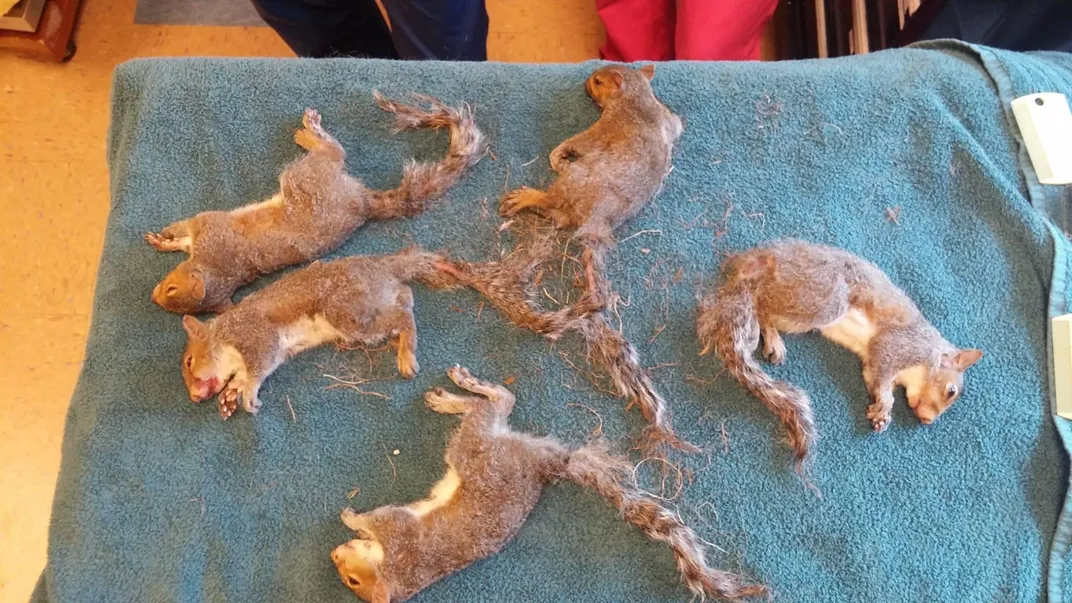Five Baby Squirrels Saved From Truly Knotty Predicament
Five gray tree squirrels in Wisconsin were found with their tails hopelessly knotted together, requiring some help from a wildlife rehab
/https://tf-cmsv2-smithsonianmag-media.s3.amazonaws.com/filer/a4/dc/a4dcef94-51d8-4130-b029-d7639de08c8c/squirrel_tales.jpg)
A squirrel’s most iconic feature—its luxuriant, bushy tail—isn’t just for show. The furry appendage keeps the arboreal rodent balanced while running along tree branches or power lines and serves as a nice portable snuggle shelter when the temperature drops. But for five young eastern gray squirrels in Wisconsin, their tails became death traps when they got tangled and entwined with strands of grass and plastic, reports The Guardian.
According to a Facebook post, the squirrel siblings were brought into the Wildlife Rehabilitation Center at the Wisconsin Humane Society in Milwaukee after someone found the struggling animals bound together. The Center believes that the squirrels got helplessly tangled because of the long grass and strips of plastic their mother used to build their squirrel nest.
“You can imagine how wiggly and unruly (and nippy!) this frightened, distressed ball of squirrelly energy was, so our first step was to anesthetize all five of them at the same time,” the wildlife center writes.
They then set to work on the impossible task unraveling the “Gordian knot” of squirrel tails, carefully snipping tangled fur away from weedy grasses and plastic bits that their mother used the make her nest. The tail detangling operation took about 20 minutes. All of the squirrels had some degree of tissue damage from the entwinement, and while three of the siblings came away with relatively luscious tails, the other two will look a little ratty for a while.

In an update, the wildlife center says that a few days after the procedure all the squirrels seem alert and lively, and they’re happily eating nuts, seeds and fruit. The wildlife center plans to hold them a little while longer to make sure there is no necrosis, or permanent tissue damage, to their tails before releasing them into the wild.
“We can only imagine how relieved they must feel to be free of one another, and move independently. They are thrilled to be able to climb and jump, which juvenile squirrels need for proper development at their age,” they write.
There’s little doubt that the squirrel twirl was a potentially fatal bind. “If they had been left alone, they would have died,” Angela Speed, vice president of communications for the Wisconsin Humane Society tells Emily Lipstein at Gizmodo.
The phenomenon is similar to a semi-mythological phenomenon called a “rat king,” in which a nest of rats gets their tails tangled creating a writhing, snarling wheel of rodents. While a rat king has never been documented in the modern age, it turns out “squirrel kings” are uncommon but not unheard of. “[One of our volunteers] has seen this before, but we’ve never had five tangled like this,” Speed tells Lipstein.
Earlier this year, a homeowner in Elkhorn, Nebraska, found a knot of six baby fox squirrels with their tails snarled together because of tree sap. Those poor dears were anesthetized and untangled by Nebraska Wildlife Rehab during an hour-long process. In May 2017, a clot of four baby squirrels was also discovered in Maine and in 2013 six squirrels in Regina, Saskatchewan, were also saved from the same sappy predicament.